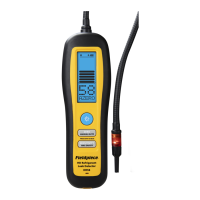01
06
02
07
03
08
04
09
05
10
Certifications and
Compliance
EN 14624 Regulatory Compliance Mark
Waste Electrical and
Electronic Equipment
Restriction of Hazardous
Substances Compliant
Description
Compact and rugged, the DR58 Heated Diode
Refrigerant Leak Detector helps you nd leaks
fast in the eld. Its heated diode sensor detects
all HFC, HCFC, CFC, HFO, HN (tracer gas), and
blends.
Multiple indicators and sensitivity 20x higher
than soap bubbles make it easy to track down
even the smallest leaks in various environments.
A red LED ashes at the tip so you can keep
your eyes on the target. The large bars on the
backlit LCD are easy to see in bright sunlight or
low light, and the numerical value provides an
extra digit of resolution.
Unlike conventional leak detectors, you have
full control with both an automatic (AZERO) and
manual (MZERO) zero mode.
The large Li-ion rechargable battery provides
over 18 hours of continuous operation and is
convenient to charge via USB-C. Replaceable
tips lter out water and dust while getting into
tight spots. All wrapped up in a ruggedized IP54
housing, it's built for the eld.
What's Included
DR58 Heated Diode Refrigerant Leak Detector
Heated Diode Sensor (RHD1)
Blow Molded Carrying Case (ABM2)
AC Charger and USB-C Cable (RCA3)
5 x Filter Tips and Gaskets (RFT6)
Operator’s Manual
1 Year Limited Warranty
Specifications
Sensor Type: Heated diode
Sensor Life: 300 hours typical
Sensitivity Levels: High, medium, low (selectable)
Maximum Sensitivity:
0.03 oz/yr (1g/a), stationary; 0.1 oz/yr (3g/a), in motion
Detection Feedback:
Red tip LED, LCD bar graph, LCD digits, beeper
Refrigerants: HFC, HCFC, CFC, HFOs, HN(tracer gas), and blends
Response Time: <1 seconds typical
Recovery Time: <10 seconds typical
Battery Type: 3.7 VDC (nominal) 2550mAh, non-replaceable
Charge Time: 6 hours typical with included charger.
Battery Life: 18 hours typical, backlight o
Auto Power Off: 10 minutes without detection or button press
Operating Environment:
32°F to 104°F (0°C to 40°C); < 75% RH (non-condensing)
Storage Temperature: -4°F to 140°F (-20°C to 60°C); < 80% RH
Weight: 14 oz (400g)
Water Resistance: Designed to IP54
US Patent: www.eldpiece.com/patents
Heated Diode
Refrigerant
Leak
Detector
OPERATOR'S
MANUAL
Model DR58
WARNINGS
Inhalation of high concentrations of refrigerant vapor can block
oxygen to the brain causing injury or death.
Do not use this device in a combustible gas atmosphere or with
A3 refrigerants such as R-290, propane or R-600, isobutane.
Do not block exhaust port or device or will not function properly.
Quick Start
1. Install sensor (see next panel for details).
2. Move to a refrigerant-free environment and
hold until your DR58 powers on.
3. Allow warm-up (calibration) to complete.
Total used sensor hours is also displayed.
4. Begin searching for the leak source.
Move the tip slowly (~3 inches/sec) and as closely
as possible to the suspected refrigerant line.
5. Search until refrigerant gas is detected.
Red light flashes, audible alarm triggers, and the
display indicates the relative gas concentration.
6. Conrm leak source.
Move tip away from alarm location for a few
seconds to clear the sensor. Return tip back to
suspected leak, looking for the highest value.
Sensor Installation
1. Ensure your DR58 is powered o.
2. Remove the 3 screws of the sensor cap.
3. Pull the sensor cap away from the back case.
4. If replacing, pull out the old sensor.
5. Push new sensor (RHD1) into pin holes. Pin
orientation does not matter.
6. Push sensor cap back onto back case and
secure with the 3 screws.
7. If replacing, hold and SENSITIVITY 5 sec to
reset sensor hours. Hold ZERO to conrm or
to cancel.
Maintenance
CLEANING: Clean the exterior with a damp
cloth. Do not use detergents or solvents.
BATTERY CHARGING: Recharge the internal
battery as needed using the USB-C cable. In
addition to the AC plug, most generic USB ports
supply enough power to charge. The long life Li-
ion rechargable battery is permanently installed.
To maximize battery life, minimize time spent at
100% full or 0% full.
SENSOR REPLACEMENT: Depending on gas
exposure, the RHD1 sensor should be replaced
after approximately 300 hours of use.
FILTER REPLACEMENT: The hydrophobic
lter is built into the replaceable tip and should
be replaced periodically to maximize sensor life
and performance. Five ltered tips (RFT6) are
included. Unscrew the tip to remove.
Functionality Test
Use a refrigerant tank and a cap to check if
your DR58 is detecting refrigerant properly.
UK Conformity Assessed
Filtered Tip (RFT6)
Heated Diode Sensor (RHD1)
1. Tightly cap a refrigerant
tank port to seal it.
2. Open valve to
coat the inside
of the cap, then
close the valve.
3. With DR58 set to high sensitivity (H), remove
the cap and wave the tip over the cap. You
should see a very large leak size of approxi-
mately "99" and a full bar graph. If not, the
ltered tip or sensor may need to be replaced.

